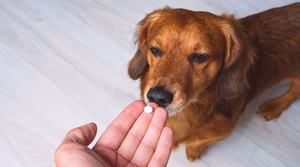Some people might find it hard to believe that an animal like a dog can be stressed or suffer from depression. However, most dog lovers know firsthand that dogs, like humans, experience a wide range of emotions.
If you’re wondering how to tell if a dog is depressed or stressed, the signs are actually very similar to stress and depression in human beings.
Continue reading for a complete guide explaining what depression and stress is in dogs, symptoms to look for, what causes these issues, and common treatments to get your dog feeling better in no time.
How to Tell If a Dog is Depressed or Stressed?

As mentioned previously, stress and depression in dogs is like these same conditions in people.
The best way to tell if a dog is depressed or stressed is to watch for major differences in their regular behavior, especially during times of change, uncertainty, or disruption to their normal routine.
It’s important to note that while dogs experiencing stress and feeling down in these situations is common, a dog suffering from long term, clinical depression is rare.
Spotting the Signs of Stress in Your Dog

When you suspect that your dog might be feeling stressed or depressed, look out for these common signs and symptoms:
- Acting withdrawn
- Significant decrease in activity
- Changes in their eating or sleeping habits
- Not participating in activities they usually enjoy
- Uncharacteristic signs of aggression
- Unusual howling or whining
Why Is My Dog Feeling Depressed?

When moving your dog into a new home, they will most likely feel insecure or feel stress.
There are numerous reasons why your dog might be feeling stress or experiencing depression.
If you notice one of more of the above signs, your first step should be to have your dog assessed by a veterinarian. This is because some of symptoms of depression could be caused by an underlying health issue. For example, a major decrease in your dog’s physical activity might be caused by untreated arthritis.
Once you’ve ruled out physical explanations for your dog’s changed behavior, consider whether they are going through any major upheavals in life, such as:
- Moving to a new house
- Introducing a new romantic partner, spouse, or baby to the home
- Adjusting to a new pet
- Changes in their schedule (i.e., a stay-at-home owner taking on a full-time job away from home)
- Loss or separation from an owner (due to death or rehoming, for example)
- Loss of a companion pet
- Picking up on grief/depression experienced by their owner or family
- Under stimulation or boredom
Like children, our pets require stability to thrive. Unexpected things do happen, but when planning big changes trying to consider how your dog may feel and doing your best to ensure a smooth transition can help mitigate some of these stressors and avoid depression in your dog.
5 Effective Ways to Treat Dog Depression

1. Counterconditioning and Desensitization
In some situations, techniques called counter-conditioning and desensitization can be helpful in getting a depressed dog used to a new situation in the home.
A good example of when this can be used is if your dog is anxious or stressed about a new pet in the house. Let’s say you have an older dog and suddenly introduce another dog to the household. Instead of being excited about his new friend, your dog reacts badly by becoming aggressive, withdrawn from you, and experiences a decrease in activity.
These signs of stress and/or depression are a good indication that it might be a good idea to take things a little slower. Some ways that you can do this is to take the dogs to a neutral place that isn’t the home (because dogs can be territorial) and allow them to see/smell each other from a distance.
You can also keep them in separate spaces in the house with doors or dog gates separating them so they can get used to each other’s scent, sights, and sounds without being thrown together too quickly.
Take Note
The main idea of these techniques is to introduce your dog to the thing that is triggering them slowly and gradually. It’s important that as you work to get the dogs used to each other you make sure the experience is positive!
You may start by giving your dog his favorite treats when he sees the other dog at the park and doesn’t react aggressively. Gradually work towards having them play alongside each other, and then together. This is so they start to associate each other with positive, fun things.
Make sure to give your dog plenty of attention when the other dog is around so they don’t feel replaced.
2. Separation Anxiety Remedies
If your dog is suffering from separation anxiety there are several approaches you can take to help.
Behavior Modification
Behavior modification techniques like basic training and learning to perform new tricks can be useful for dogs with separation anxiety. Dedicating time to training gives your dog special bonding time with their person and gives them something productive to focus on.
Another way to modify your dog’s behavior when they are stressed or depressed is by making sure that you only reward positive behavior and not negative behavior. Don’t shower your dog with treats when they are moping around for example but give praise and positive reinforcement when they are showing normal behavior like wagging their tail, playing, or doing other things they enjoy.
Exercise
Just like humans, dogs benefit a lot from regular exercise like daily walks, playtime, and other activities they enjoy. Exercise can improve your dog’s overall health and mood, which is great for dogs who are suffering from depression. Regular exercise can also provide your dog with a sense of routine.
Pheromones
According to Jacqui Neilson, DVM, DACVB, pheromones are a “type of chemical communication between members of a species.” The type of pheromones used to treat separation anxiety are known as ‘calming and appeasing pheromones.’
Synthetic versions of these pheromones are sold in various forms including sprays, diffusers, chews, and collars, so as an owner you can choose the most convenient way for your furry friend to receive this treatment.
Medications
Two medications approved in the United States to treat separation anxiety in dogs are clomipramine (Clomicalm®) and fluoxetine (Prozac®), also used to treat depression and anxiety in humans.
3. Medication if Clinical Depression
Like separation anxiety, medications used to treat clinical depression in dogs are the same ones used to treat depression in humans. Two medications that are commonly used are Zoloft and Prozac. These medications are usually a last resort. If depression is diagnosed early on, other interventions are usually effective.
Keep in mind that it may take up to two months to see improvements in your dog if they start to take one of these medications. The good news is that unlike humans, your dog may not need to be on this medication indefinitely. Although some may require ongoing medication, many see improvements and can wean off in approximately 6 to 12 months.
4. Adopt Another Pet or Carer
If you think that your dog might be lonely or missing companionship in their life after a loss, consider adopting another pet or someone to care for your dog when you aren’t around, like a pet sitter.
Take Note
Before adopting another pet ask yourself if you have the time/energy for both pets and are willing to take the time to properly introduce them.
If the situation isn’t right to bring another pet into the home, other great alternatives include playdates with other dogs at the park, doggy daycare, or training classes that involve socializing with other dogs and owners.
5. Patience and Time
As you can see, there are many different approaches you can take to treat signs of depression and stress in your dog. It’s always a good idea to consult with your vet for professional guidance to determine the right approach for the situation you’re in.
The key is not to get discouraged. Just like humans, sometimes dogs feel down in the dumps and there’s not always a simple solution. It may take a few days or even few months, but chances are your dog will snap out of it sooner or later (just like us humans!).
Whatever you do, have faith, and don’t give up. Even something as simple as little extra TLC each day can go a long way in making your dog feel loved and secure. It will all be worthwhile when you start to see your dog enjoying life again.




